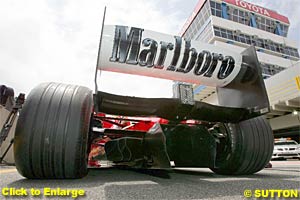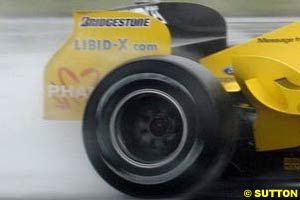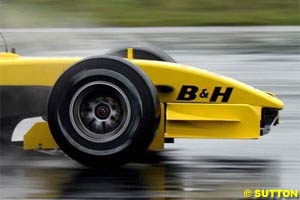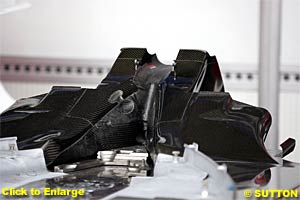
Atlas F1 Technical Writer
The FIA revealed the 2005 rules in Brazil, while few teams introduced new car updates for the final race of the season. Atlas F1's Craig Scarborough comments on the new regulation changes and reviews the teams' performances in the changeable weather and difficult conditions of last weekend's race in Interlagos
Setup and Layout
Interlagos is quite a unique track. It takes cues from other circuits; like Suzuka it runs anticlockwise, and its three sectors are split into two fast and one slow sections, starting along the main straight with speeds reaching 320kph before the tight opening sequence of corners and into another straight. The mid section is all twists and turns which lead onto sector 3, which is a flat out blast uphill to complete the lap.
As the lap is so clearly defined between fast and slow corners the set up demanded from the car is a fine balancing act, mixing low downforce for the straights and grip for the slow corners. Added to this mix is the need for the car to react to the bumpy surface, the resulting soft suspension set up aids low speed grip but makes the car less settled at speed. Not only is the track bumpy but it's also abrasive and dirty, which hurts the tyres.
Already at an altitude well above sea level, the circuit features gradient changes akin to Spa. Strangely, the exact altitude stated by each team varies by nearly 100 metres, which is perhaps indicative of the extent of the gradient changes around the circuit!
As the air is thinner at this altitude the engine loses over 70BHP, admittedly affecting all the teams equally. As the middle sector is so slow the engines are only at full throttle for just over half the lap. The slow middle sector may give the engine a rest from high revs, but the bumps can cause the rear wheels to lose traction, either under power or braking. The engine management system can monitor this, closing the throttles off to prevent the wheels spinning if the car is accelerating, or opening them to prevent locking under braking.
New Rules
The teams have failed since September to decide one of the options proposed by the FIA, as they couldn't reach an agreement between them. The FIA have implemented their own choice of the rules, so it was no surprise that option 2 was the chosen set up. This means that the teams have only the four months leading up to Melbourne 2005 to design and build a car to the new rules. Already some teams have announced they will run new cars from the first race, while a more realistic choice will be running an interim car until the first European race, allowing more time to refine the overall design and complete more testing. They also have to test tyres that will last to the new limitations, and evolve strategies to make the new race weekend format work in their favour.
The rules for 2005-2006 are made up of 10 areas:
Aerodynamics
Engines
Considering the enormity of the change for the teams the one engine per weekend rule posed for them this time last year, the new two weekends per engine rule seems less threatening. At the first race this year, some teams had engines on a par power wise with 2003; by the end of this season power outputs had risen to a quoted 960 BHP. The impact of the new rule will probably not prevent the FIA's feared 1000 BHP peak being reached by the end of 2005.
While the engine manufacturers will be confident the engines will last the two races, they will no doubt introduce running restrictions to limit engine life over the two weekends. Untimed practice sessions will use reduced revs, and in the latter part of the engine's first race could see drivers easing off dramatically to preserve the engine. This could in fact hinder racing, as less risks would be taken late in the race with engine life in mind.
Moving into 2006, the reduced engine cylinder count and resulting capacity decrease will cut outputs dramatically. Taking a reasonable estimate of the BHP per litre by the end of next year of 325 BHP/L equates to around 780 BHP for a 2.4 litre engine. Of course the FIA are proposing some design restrictions which may cut that estimate back somewhat, but yearly development reaping around 20 BHP will see 900 BHP V8s by the close of the decade.
Weekend format
Not a technical rule per se, but the running order for weekend has also changed. Making tyres last from qualifying until the races end will have a profound effect on pace and race strategy. Of course, making one set of tyres as durable for use in a three-stop race will see less grip and potentially dangerous wear at some tracks; many races this year have seen tyre failures at circuits with high wear or sharp kerbs. Pitstops will no longer require the teams to change tyres; after the "love it or hate it" combined fuel and tyre stops, seeing a car pit with only the two refuelling mechanics will be a sparse sight. This may deter teams from making multiple stops at circuits with low penalty for heavy fuel loads.
The FIA's press release was not clear if these tyres need to last for both qualifying sessions, which now both count towards the grid order, with the first session run on Saturday with low fuel and in reverse order from the last race. The cars then will be locked in a similar parc ferme set up but allowed to refuel for the second qualifying session (now on a Sunday morning) and the race. No longer will the first session see strategic running, allowing drivers to seek an earlier or later run in the second session, to gain advantage from finding a faster late lap or avoiding weather windows. Hence the first session will be a real qualifying lap flat out with low fuel, albeit not resulting in a clear grid position. How TV will reflect this new layout and find time to broadcast the crucial Sunday session is uncertain.
Safety
Aerodynamics
Putting the diffuser into the rules is a critical addition, as the diffuser provides around half of the rear downforce and very little drag; reducing the diffuser height limits the downforce for cornering, but will not produce greater straight-line speeds.
Balancing the changes at the rear is a major change to the front wing height. The wing is required to be raised 50mm above the last wing height change in 2000, while the central section is still allowed to be at floor level. A higher front can take less advantage from ground effect, and increases the disruption to airflow over the rest of the car.
Sadly, the hope of seeing cars slipstreaming, sliding in corners, or even overtaking will not be realised with these rules. Dependence on downforce will still be the overriding factor preventing overtaking, and the teams' knowledge of vehicle dynamics will never allow dramatic cornering angles.
Team by Team
Ferrari
Unusually for Ferrari they struggled on Friday morning; only in the afternoon session with more rubber on the track and some work on set up did they find a balance with some speed in it; Michael Schumacher was still unsure of how the car was behaving, which was confirmed the following day. Schumacher's unease with the car's set up for the race and over the bumps was increased when a stray dog on the track shortened the morning session to twenty minutes.
It was with Rubens Barrichello still setting the pace that Schumacher lost control under braking into turn 6 and smashed hard into the barriers; after a brief fire from the broken oil lines he was able to get out of the car unscathed. The car was not so lucky, with heavy damage not both the chassis and engine; he would take to the spare chassis with a new engine, costing him ten grid places. Qualifying went well for Barrichello, who easily posted the fastest time and looked good for the race. Schumacher's woes worsened as he struggled with the set up on the spare car and, heavy with fuel, made a bad attempt at his second qualifying time.
Going into the race the damp conditions put Bridgestone's tyres in a bit of a bind; too dry for wet tyres and too wet for slicks, the intermediates both drivers started with were outpaced by the Michelins, and Schumacher was in for slicks along with the first of the others on lap 5 after a spin in traffic while aiming for ninth place. Barrichello pitted one lap later and found he lost a lot of time in being out for the extra lap on the drying track. Both drivers struggled with getting heat into their tyres, taking almost ten laps to get into their stride, and both drivers had problems in traffic, failing to pass otherwise slower cars on the straights.
Williams
Unusually for the first Friday session Juan Pablo Montoya led Ralf Schumacher and the McLarens with equal gaps, and the afternoon session saw the drivers slip to midfield as their tyre program switched the emphasis from fast laps to longer runs. Saturday's early session also saw the cars off the very top of the time sheets until the first qualifying session, when Montoya was but a whisker off Barrichello's time and Ralf Schumacher just a few tenths behind, then for Q2 Montoya's exuberant lap again netted second fastest spot with Schumacher a similar gap behind.
At the start of the race both cars were on the Michelin intermediates and Montoya made a slower start, dropping down to fifth and then pitting with the others on lap 5 but regaining the lead after Fernando Alonso's stop and never relinquishing it until the end. Schumacher, from his lesser grid position, was rattled between two other cars going into the first corner and was the first to stop for slicks on lap 4. He lead Takuma Sato throughout the first two stints until his shorter middle stint left him behind the BAR until he was able to re-pass into fifth a few laps from the end.
McLaren
Although Friday saw a spin for Kimi Raikkonen and a slow second session for David Coulthard the team's pace was up in the top three teams, boding well for the rest of the weekend. Saturday's morning sessions were equally good, with Coulthard spinning this time around but both drivers on a par with each other. First qualifying saw the drivers paired together with midfield times, but Raikkonen came through with a clean lap for third on the grid while Coulthard lost time with oversteer in sector 1 and even more through the lap.
Raikkonen's start and opening laps proved the grip he had in the car and Michelin tyres; he retained the lead until Barrichello's tyres warmed and he slipped back to second. He soon stopped for slicks and effectively followed JPM to the end; a skirmish in the pit lane at their first stop saw him regain the lead, only to lose it again on the following straight. Coulthard took a gamble on slicks from the start and slipped rapidly down the order, being bumped by other cars in the process; he then stopped quite early for a scheduled stop on lap14. He then followed Jacques Villeneuve's car to the end, unable to pass.
Renault
One of the few teams to opt for dry tyres at the races start, this at first seemed like a gamble gone wrong as Alonso spun from eight to fifteenth, only just ahead of his teammate on lap 1. As the track rapidly dried he was able to regain positions, and by the time he was the fastest car on track the other drivers had to make a stop for tyres that he wouldn't require. Both drivers were on a two stop strategy, on laps eighteen and forty seven (not changing front tyres) for Alonso while Villeneuve made a shorter middle stint.
BAR
Again running their "Suzuka special" engine, all three drivers completed typically competitive runs on Friday, without any reported problems. Saturday saw Sato struggle in the morning sessions, only to overcome the deficit with a faster lap in Q1 and a time close to Jenson Button in Q2; Button had an oversteering moment during his Q2 lap, costing him time.
On the grid on Sunday Button's car was smoking as the lights were gong out; the fire inside the engine bay led to overheating and he retired within four laps. Sato settled in on his wet tyres and pitted intelligently early on Lap 5. He did not have the straight line speed to overtake on the straight, losing out on fifth place right at the end of the race.
Sauber
Friday saw the team split on fortunes; Felipe Massa was happy with his car but Giancarlo Fisichella struggled between understeer and oversteer. Saturday saw their fortunes equalise and then diverge for qualifying as Massa went for a possible pole lap only to get some oversteer in the fast turn 11 while Fisichella had understeer, keeping him out of the top ten. Massa shone in the opening laps, making the Bridgestone's work quicker than Barrichello, and he stayed out all the way through to lap 7 before stopping, suffering a ten place drop. Both drivers fought on during the race to finish a place apart, Massa getting a point in eighth for efforts.
Jaguar
Still talking up their progress on technical development for next year, the team was firmly in the bottom ten on Friday and often in the lower half of that. Saturday improved when Mark Webber broke into the top ten in the second un-timed session, but qualifying again saw the cars much further down the field.
Webber's first corner involved avoiding other cars and lost him time, while Christian Klien made a clean run and got up to eighth from fifteenth. Both stopped later than the leaders on Lap 6, and Webber was able to reel in Klien until Lap 23 when an incident into the first corner saw the cars collide, which damaged Webber's car irrevocably and forced Klien to pit for repairs. Klien was able to limp on through the race, trailing the Toyotas to the end in fourteenth.
Toyota
Trulli's reputation in qualifying was upheld on Saturday with tenth position on the grid, while Ricardo Zonta made some set up changes, including raised the ride height to avoid grounding, and upset the aero balance, causing understeer. In the race Trulli made a good start, gained some positions and stopped on the optimum lap 5. They then ran in sequence for the large part of the race, finishing just out of the points.
Jordan
Jordan tested a 2005 spec car in expectation of the option 2 rules being adopted. The simple run at the straight-line facility at Elvington in the UK was largely to correlate windtunnel data to track results; the fact that the test was run in the rain hindered the results. Rumours of a Toyota engine deal to replace the Cosworth unit were continuing, and bode well for the teams' future.
For Friday the team contended with nervous handling, particularly at the rear over the bumps. Qualifying still produced the ninth row pace, albeit altered on the actual grid due to Michael Schumacher's engine change. Their set up had already been tweaked for a wet race; this was paying off for Nick Heidfeld until clutch problems halted his race, while Timo Glock managed to finish back in fifteenth place.
Minardi
Friday's session was problem free for the two race drivers, while third driver Bas Leinders suffered hydraulic problems, keeping him from running in the morning session. Qualifying saw the back row times taken up by the Minardi drivers after engine changes during the lunchtime break. Gianmaria Bruni had a problem after his first qualifying lap and did not run in the second session; this allowed the car to be set up for the expected wet race conditions. Unfortunately this idea backfired when the wet tyres he started the race with proved to be unnecessary as the track dried, forcing him to pit on lap 8. Zsolt Baumgartner ran inters, stopping earlier on lap 6, and the pair then exchanged positions as their pitstops windows were out of phase in the middle stints.
This year, the Formula One circus ends the season at the carnival like atmosphere of Sao Paolo in Brazil. One of Formula One's trickiest circuits, the weather leading into the race conspired to make conditions even trickier. Once again there was very little of technical interest on the cars, but both the FIA and the teams were working to firm up the technical and sporting rules for the next few years. Initially this came in the form a FIA press release confirming the aerodynamic rules for 2005 and then the teams, working behind the scenes, introduced potential cost cutting testing proposals.
 Reducing the cars speed makes up the majority of new rules, while cost cutting and safety related changes are also included. Reducing speed is achieved as usual by cutting downforce, although these changes are quite carefully structured to keep drag at the same level, which results in slower corner speeds while keeping straight-line speeds capped.
Reducing the cars speed makes up the majority of new rules, while cost cutting and safety related changes are also included. Reducing speed is achieved as usual by cutting downforce, although these changes are quite carefully structured to keep drag at the same level, which results in slower corner speeds while keeping straight-line speeds capped.
 Moving the rear wing forward decreases the leverage effect of the wing, and also places it in closer proximity to disturbed air coming off the rear bodywork. This keeps the wing frontal area drag the same, but limits its ability to create and transfer downforce to the car. There is an exacerbation of the impact on downforce by moving the rear wing forward; the wings interact with the diffuser and lower wing beam, which all work together to allow more aggressive wing angles. The flow structures through the wing and diffuser are all integrated; one would stall without the other shaping the flow. As they have now been disjointed the net effect will be markedly less downforce than the losses from the individual changes.
Moving the rear wing forward decreases the leverage effect of the wing, and also places it in closer proximity to disturbed air coming off the rear bodywork. This keeps the wing frontal area drag the same, but limits its ability to create and transfer downforce to the car. There is an exacerbation of the impact on downforce by moving the rear wing forward; the wings interact with the diffuser and lower wing beam, which all work together to allow more aggressive wing angles. The flow structures through the wing and diffuser are all integrated; one would stall without the other shaping the flow. As they have now been disjointed the net effect will be markedly less downforce than the losses from the individual changes.
 While the cars will be shorn of 25% of their downforce from the rules, the teams will have grabbed from a third to a half of that back by the time their definitive cars will race next year. Next year the effect will be two fold; some teams will have got better results from their wind tunnel work, and as a result will be faster on track. Realistically the better resourced teams will find the bigger gains, but there is always the scope for a lesser funded team to get a jump on the opposition with a design innovation; this advantage would only last one season at best. Potentially a top team could get their sums wrong, shifting the balance of power.
While the cars will be shorn of 25% of their downforce from the rules, the teams will have grabbed from a third to a half of that back by the time their definitive cars will race next year. Next year the effect will be two fold; some teams will have got better results from their wind tunnel work, and as a result will be faster on track. Realistically the better resourced teams will find the bigger gains, but there is always the scope for a lesser funded team to get a jump on the opposition with a design innovation; this advantage would only last one season at best. Potentially a top team could get their sums wrong, shifting the balance of power.
 Renault ran rear suspension modifications in Brazil, although they kept the one piece titanium upper rear wishbone used since Silverstone. Friday was problem free aside from a lack of grip on the green track, while qualifying saw fair performances from both drivers, albeit not as high as the team would have liked.
Renault ran rear suspension modifications in Brazil, although they kept the one piece titanium upper rear wishbone used since Silverstone. Friday was problem free aside from a lack of grip on the green track, while qualifying saw fair performances from both drivers, albeit not as high as the team would have liked.
 Having struggled over bumps since their arrival in Formula One, Interlagos should not have been a good track for the team. However, with Mike Gascoyne's technical input and Jarno Trulli's arrival, more energy has been injected into the team in the latter part of the season. Friday morning went well for the team, with third driver Ryan Briscoe almost topping the timesheets and Trulli well in the top ten, and the later session seeing the team drop back down as they focused on tyre evaluation.
Having struggled over bumps since their arrival in Formula One, Interlagos should not have been a good track for the team. However, with Mike Gascoyne's technical input and Jarno Trulli's arrival, more energy has been injected into the team in the latter part of the season. Friday morning went well for the team, with third driver Ryan Briscoe almost topping the timesheets and Trulli well in the top ten, and the later session seeing the team drop back down as they focused on tyre evaluation.
|
Contact the Author Contact the Editor |
Please Contact Us for permission to republish this or any other material from Atlas F1.
|
Volume 10, Issue 43
Articles
The Eye of the Storm
Ann Bradshaw: Point of View
Every Other Sunday
2004 Brazilian GP Review
2004 Brazilian GP Review
Technical Review: Brazil 2004
No surprises
A Finale without a Farewell
Stats Center
SuperStats
Charts Center
Columns
Season Strokes
On the Road
Elsewhere in Racing
> Homepage |